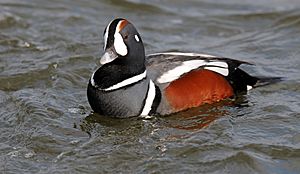Sea ducks facts for kids
Quick facts for kids Sea ducks |
|
|---|---|
 |
|
| Harlequin duck, Histrionicus histrionicus (male) | |
| Scientific classification |
|
| Kingdom: | Animalia |
| Phylum: | Chordata |
| Class: | Aves |
| Order: | Anseriformes |
| Family: | Anatidae |
| Subfamily: | Anatinae |
| Tribe: | Mergini Rafinesque, 1815 |
| Genera | |
|
Clangula |
|
Sea ducks (Mergini) are a special group of ducks. Most of these birds spend their winters near the ocean. They have amazing ways to live in salty water.
Many sea ducks have special glands that help them drink salty ocean water. Young sea ducks don't have these glands yet. Some types of sea ducks like to live in rivers instead. Almost all of the 22 kinds of sea ducks live in cold, northern places.
Some sea ducks, like mergansers and smew, eat fish. They have bills with jagged edges, like a saw. This helps them grip slippery fish. Other sea ducks dive underwater to find food. They eat things like clams and crabs from the seafloor.
Sea ducks change their feathers during the year. In late summer, they get a dull "eclipse plumage." Then, in winter, they grow their bright breeding feathers.
Contents
Types of Sea Ducks
There are twenty-two different kinds of sea ducks. They are grouped into ten main families, called genera.
Long-tailed Ducks
- Genus Clangula
- Long-tailed duck (Clangula hyemalis)
Harlequin Ducks
- Genus Histrionicus
- Harlequin duck (Histrionicus histrionicus)
Labrador Ducks
- Genus †Camptorhynchus
- †Labrador duck (Camptorhynchus labradorius) (This duck is now extinct, meaning it no longer exists.)
Steller's Eiders
- Genus Polysticta
- Steller's eider (Polysticta stelleri)
Eiders
- Genus Somateria
These are large ducks that live in the sea. Male eiders have black and white feathers. They also have unique patterns on their heads. Female eiders are usually brown.
-
- Spectacled eider (Somateria fischeri)
- Common eider (Somateria mollissima)
- King eider (Somateria spectabilis)
Scoters
- Genus Melanitta
Scoters are strong, chunky ducks that live in the ocean. Male scoters are mostly black and have large, swollen bills. Female scoters are brown.
-
- Common scoter (Melanitta nigra)
- Black scoter or American scoter (Melanitta americana)
- Velvet scoter (Melanitta fusca)
- White-winged scoter (Melanitta deglandi)
- Surf scoter (Melanitta perspicillata)
Goldeneyes
- Genus Bucephala
Goldeneyes don't spend as much time in the ocean as other sea ducks. They often spend winter on freshwater lakes and rivers. Male goldeneyes have white bodies with black backs and special head markings. Female goldeneyes are grey with chestnut-colored heads.
-
- Common goldeneye (Bucephala clangula)
- Barrow's goldeneye (Bucephala islandica)
- Bufflehead (Bucephala albeola)
Smews
- Genus Mergellus (Sometimes this group is included with Mergus ducks.)
- Smew (Mergellus albellus)
Hooded Mergansers
- Genus Lophodytes (Sometimes this group is included with Mergus ducks.)
- Hooded merganser (Lophodytes cucullatus)
Typical Mergansers
- Genus Mergus
These ducks are the least likely to live in the ocean. Only the red-breasted and common mergansers are often found at sea. They are large ducks with saw-like bills. They dive underwater to catch fish.
-
- Red-breasted merganser (Mergus serrator)
- †New Zealand merganser (Mergus australis)
- Common merganser or goosander (Mergus merganser)
- Brazilian merganser (Mergus octosetaceus)
- Scaly-sided merganser (Mergus squamatus)

